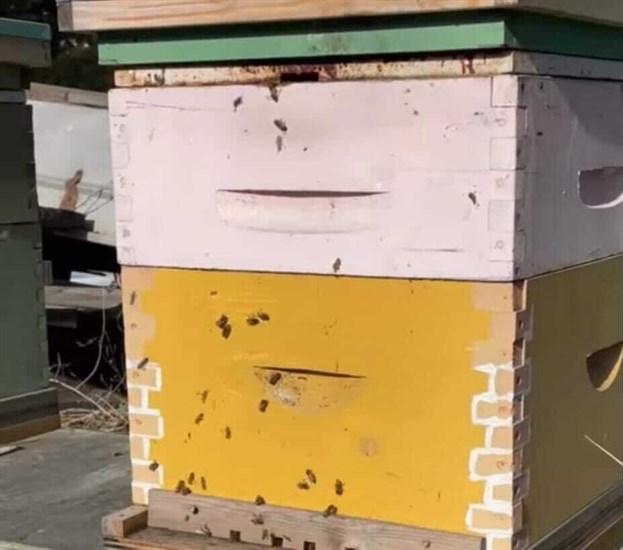
A photo of a honey bee hive owned by Murray Willis in Kamloops.
Image Credit: SUBMITTED/ Andy Philpot
February 03, 2022 - 6:30 AM
Honey bees are seen in the spring and summer buzzing around collecting pollen and nectar to make delicious honey, but have you wondered what they do during the winter?
Bee behaviour is much different during the cold months when they use brilliant techniques to survive.
“They are fascinating and I never stop learning new things about them,” said Kamloops beekeeper Murray Willis.
Honey bee behaviour is intricate and systematic throughout the seasons, and in the winter season their behaviours are no less captivating. Willis owns 50 hives and studies their behaviours through plexiglass windows when they are clustered inside the hives during cold temperatures.
“During the winter they keep humidity and temperatures stable by eating stored honey and vibrating their wings and bodies,” Willis said. “The whole reason is to keep the queen alive. I have humidity and temperature gauges I monitor, they keep it around 80 degrees Fahrenheit (27 C).”
READ MORE: Okanagan orchardists seeing impact of honeybee shortage
Willis said in the fall the hives downsize in numbers from about 50,000 to about 20,000 bees to preserve their honey supplies.
“In the fall, they kill the male drones off who only want to eat honey,” he said. “A hive will consume 80 to 100 lbs of honey over the winter to keep warm.”
On sunny, warm days in winter, the bees will go outside the hive for a surprising reason.
“When it warms up they will fly out and poop and drop off the queen’s poop,” Willis said. “They keep their hives really clean. You might see little droppings on your car during these days. Then they go back in for another couple of months.”
The queen lays up to 3000 eggs per day but she goes into neutral over the winter. A queen bee lives for three to five years.
“We get a lot of our queens imported from Hawaii, a bee farm there raises them,” Willis said. “Everyone likes to start in April and we can’t raise them that early. I do raise some of my own but it happens in June.”
READ MORE: iN VIDEO: The challenges faced by these Kamloops beekeepers
When spring comes around again, the bees go out and find pollen from willow and maple trees and bring it back to the hive. The pollen stimulates the queen to get laying.
“We get excited when we see them bring pollen,” Willis said. “The pollen is made up of protein. Then dandelions come and that is when bees get pollen and nectar, a carbohydrate. It will look like yellow dust around their entrance.”
The queen starts laying, the hive picks up momentum and starts building in hive size, to peak in June.
“They will start bringing honey in April, May and June,” Willis said. “The summer months are the biggest ones for honey production. Then they start downsizing again to prepare for winter. We get 80 to 100 lbs of honey from each hive.”
Willis started studying bees a decade ago when he saw a demonstration on beekeeping and extracting honey at the PNE and collecting beekeeping equipment shortly after.
He calls the honey his bees produce ‘The Neighbourhood Blend’, a blend of nectar collected mostly from clover and alfalfa.
To contact a reporter for this story, email Shannon Ainslie or call 250-819-6089 or email the editor. You can also submit photos, videos or news tips to the newsroom and be entered to win a monthly prize draw.
We welcome your comments and opinions on our stories but play nice. We won't censor or delete comments unless they contain off-topic statements or links, unnecessary vulgarity, false facts, spam or obviously fake profiles. If you have any concerns about what you see in comments, email the editor in the link above.
News from © iNFOnews, 2022